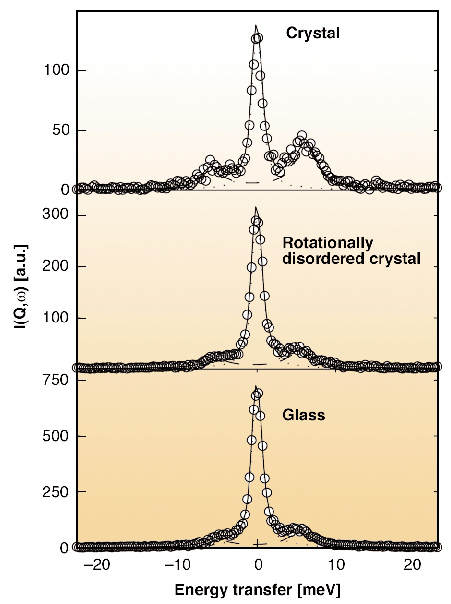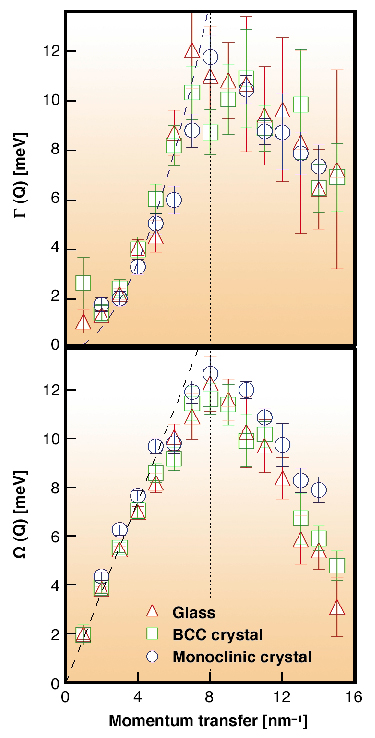- Home
- Users & Science
- Scientific Documentation
- ESRF Highlights
- ESRF Highlights 2004
- High Resolution and Resonance Scattering
- Crystal-like Nature of Acoustic Excitations in Glassy Ethanol
Crystal-like Nature of Acoustic Excitations in Glassy Ethanol
It is well known that disordered materials exhibit anomalies in their dynamical and thermal properties compared to the Debye model and the behaviour of crystals. The anomalies are commonly linked to the nature of acoustic modes at wavelengths approaching typical distances of the disorder. However, the understanding of acoustic excitations in glasses is far from the level reached for crystalline solids due to both theoretical as well as experimental shortcomings. Recently there has been considerable experimental progress due to the development of high resolution inelastic X-ray scattering (IXS), enabling direct observations of longitudinal acoustic excitations in the region of the first Brillouin zone [1]. The common findings from these experiments on glasses are a linear dispersion of the acoustic modes at small wave vectors, with a slope of the dispersion corresponding to the longitudinal low frequency sound velocity, and a Q2 dependence of the linewidth of the excitations.
In this work we investigate the influence of disorder on the nature of acoustic excitations directly by comparing IXS spectra from a monoclinic crystal, a rotationally disordered BCC crystal and a glassy phase of ethanol at wavevectors corresponding to the first and second Brillouin zone of the crystal. Ethanol is one of a few polymorphic systems where glassy, rotationally-disordered, and crystalline phases can be investigated at the same temperature, enabling a direct comparison of the structural influence on the dynamical properties [2]. The different phases were prepared in situ in the cryostat using the same sample and all the measurements were performed at the same temperature, T = 86 K, at the ID16 beamline. The diffracted intensity recorded simultaneously with the inelastic experiments confirmed the phase transformations.
 |
Fig. 1: IXS spectra from the three different solid phases of ethanol at Q = 3 nm-1. |
An example of the experimental data is shown in Figure 1. At low momentum transfers, Q, one observes well-defined inelastic peaks, whereas at higher Q the inelastic component is broad and the peaks are ill-defined. The spectroscopic parameters, position, width and intensity, were extracted by fitting the spectra with a damped harmonic oscillator model for the acoustic excitations [1]. The results for the different phases are remarkably similar, as can be seen in Figure 2. They reveal an almost linear dispersion up to Q ~ 8 nm1 in all three phases, and a linewidth that approximately follows a Q2 behaviour. At higher Q the position of the excitation decreases in energy.
 |
Fig. 2: Position, |
For a crystalline sample this picture is not surprising and can be understood in the well known terms of Brillouin zones and phonon dispersion curves. Since we have a polycrystal the dispersion represents the average of the dispersion relations in the different crystalline directions and the average Brillouin zone boundary is found at Q ~ 8 nm1. For the glass, the results are more surprising. Even though the material lacks translational order, we observe a crystal-like dispersion curve with a slope that agrees well with the low frequency longitudinal sound velocity. The maximum of the dispersion curve occurs at Q = QP/2 where QP is the main peak of the static structure factor, S(Q), and the dispersion curve goes towards a minimum at QP. Thus QP acts as a reciprocal lattice point for the glass defining a pseudo-Brillouin zone for Q < QP/2. This crystal-like behaviour provides evidence that we also have phonon-like excitations in the glass with wavelengths approaching the inter-particle distance in the material. The lack of influence of the structural disorder shows that the acoustic excitations are essentially of the same nature in the glass and in the poly-crystal, in the energy region of the excess in the vibrational density of states. Thus, the origin of the dynamical anomalies in the glass cannot be directly related to significant changes in the nature of these excitations.
From our results we can also offer an explanation of the universal Q2 dependence of the linewidth for glasses [1]. Within the accuracy of the present experiment the width is the same in all three phases indicating a common origin. In the crystalline phases the increase of the width can be understood as a result of the increasing energy spread of the phonon branches in different crystalline directions. Along this line the observed linewidth in the glass can be attributed to an intrinsic averaging over different local structural orientations, and cannot be linked to the lifetime, or damping, of a single excitation, nor to the lack of short range order.
References
[1] F. Sette et al., Science 280, 1550 (1998).
[2] M. Ramos et al., Phys. Rev. Lett. 78, 82 (1997).
Principal Publication and Authors
A. Matic (a), C. Masciovecchio (b), D. Engberg (a), G. Monaco (c), L. Börjesson (a), S.C. Santucci (b) and R. Verbeni (c), Phys. Rev. Lett. 93, 145502 (2004).
(a) Department of Applied Physics, Chalmers University of Technology, Göteborg (Sweden)
(b) Sincrotrone Trieste, Trieste (Italy)
(c) ESRF



